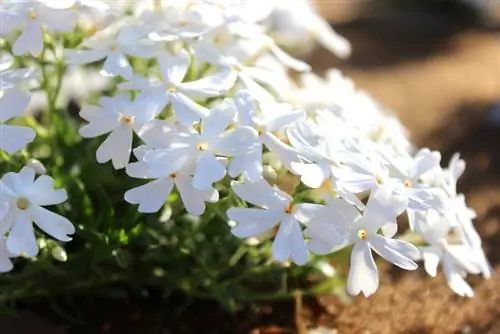- Author admin [email protected].
- Public 2023-12-16 16:46.
- Last modified 2025-01-23 11:20.
The cushion phlox (Phlox subulata) is a particularly flowery, low plant for locations such as the rock garden or in sunny beds next to dry stone walls. With relatively rapid growth and a height of only around 10 to 15 cm, the cushion phlox is a popular ground cover.

How do you optimally care for upholstery phlox?
When caring for upholstery phlox, make sure to only water it during dry periods and after planting, to fertilize it in spring and to ensure sufficient sun and well-drained soil. Pruning is not absolutely necessary, but can offer advantages.
How often does the upholstery phlox need to be watered?
When it comes to water, cushion phlox is usually a relatively undemanding plant. You should only water it regularly and in a well-dosed manner during very dry phases and immediately after planting. Please note that due to the more extreme weather conditions, potted plants placed on the terrace or balcony usually require more water than plants rooted in outdoor beds.
When and how can the cushion phlox be transplanted?
The best time for planting or transplanting cushion phlox is spring. You can also plant pre-grown specimens in the plant container at any time between spring and autumn, as long as you provide sufficient watering immediately after planting and some shading in mid-summer.
When is the optimal time to prune upholstery phlox?
Pruning is not absolutely necessary for upholstery phlox. However, it can still be useful for the following reasons:
- for obtaining cuttings for propagation
- for rejuvenating plants
- to stimulate rebloom
If you want to stimulate possible re-blooming with the cut, you should cut the plants back by about a third immediately after flowering.
Which pests and diseases affect upholstery phlox?
To the delight of many garden owners, the upholstered phlox is usually completely spared from voracious snails. Occasionally, however, phlox species can become infected with powdery mildew. The most effective measure against this is the (early) destruction of infected plant parts and a change of location.
How should upholstery phlox be optimally fertilized?
The cushion phlox is not overly demanding when it comes to nutrients. However, it has a positive effect on the growth of these plants if you provide their beds with a fresh layer of mulch once a year in spring. Instead of solid fertilizer (€18.00 at Amazon), only liquid fertilizer should be used, as solid fertilizer grains usually get caught in the fine plant cushions.
What should you consider when overwintering cushion phlox?
Since the upholstered phlox species offered in this country are usually easily winter-hardy, perennial species, no special winter protection is necessary. If dried shoots become visible on the plant cushions before or after the winter break, you can simply cut them off.
Tip
The best location conditions for cushion phlox are sufficient sun and a soil without waterlogging.






